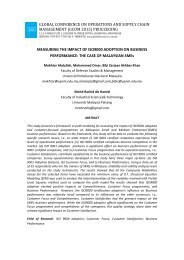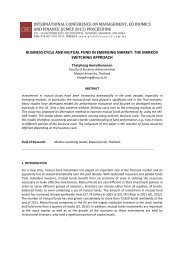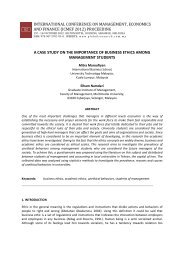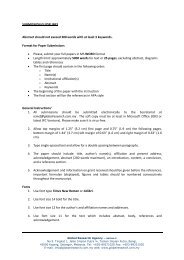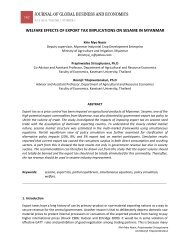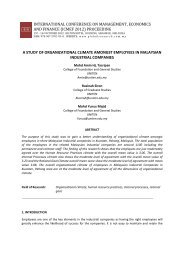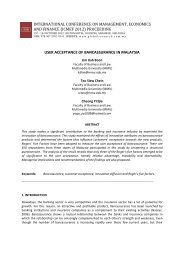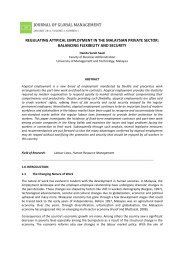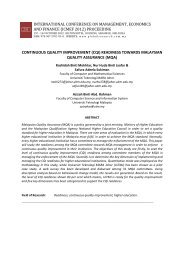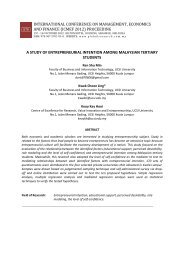(icmef 2012) proceeding developing standardized economic drivers f
(icmef 2012) proceeding developing standardized economic drivers f
(icmef 2012) proceeding developing standardized economic drivers f
You also want an ePaper? Increase the reach of your titles
YUMPU automatically turns print PDFs into web optimized ePapers that Google loves.
277<br />
INTERNATIONAL CONFERENCE ON MANAGEMENT, ECONOMICS<br />
AND FINANCE (ICMEF <strong>2012</strong>) PROCEEDING<br />
15 th - 16 th OCTOBER <strong>2012</strong>. HILTON HOTEL, KUCHING, SARAWAK, MALAYSIA<br />
ISBN: 978-967-5705-09-0. WEBSITE: w w w . g l o b a l r e s e a r c h . c o m . m y<br />
DEVELOPING STANDARDIZED ECONOMIC DRIVERS FOR MEASURING THE DEPTH<br />
OF ECONOMIC GLOBALIZATION: MALAYSIA AS A CASE STUDY<br />
Nik Fanidautty Bte Nik Ab Majid<br />
College of Business Management & Accounting,<br />
University Tenaga Nasional,<br />
Kampus Sultan Haji Ahmad Shah<br />
Pahang, Malaysia<br />
Tel: 609-4552042, Fax: 609-4552006<br />
fanidauty@uniten.edu.my<br />
Associate Prof. Dr. Mahmoud Kh Mahmoud Almsafir<br />
College of Graduate Study,<br />
University Tenaga Nasional,<br />
Kampus Putra Jaya.<br />
Tel: 609-4552042, Fax: 609-4552006<br />
mahmoud@uniten.edu.my<br />
ABSTRACT<br />
Globalization has originally started as a wave and become a well known terminology in the developed<br />
world since the fourth quarter of the last century. Since then every government has claimed that its<br />
economy is globalized. However, it is obvious nowadays that every single <strong>economic</strong> activity can become<br />
globalized, but nobody can be sure of how far this or that economy is globalised. The main goal of this<br />
paper is to develop and calculate globalization index of Malaysia’s economy for the 1970-2011 period<br />
by using new set of <strong>economic</strong> <strong>drivers</strong> namely, total trade with Japan and United State (US), number of<br />
foreign companies in Malaysia and total foreigners’ assets in Malaysia. New set of Economic Drivers was<br />
selected due to its influence on international growth rate and its status/function as the most integrated<br />
<strong>drivers</strong> in <strong>economic</strong> globalization process. Results show that Malaysia’s Economy is more globalized<br />
during the period of 1991-2010 as compared with the period of 1970-1990 using <strong>economic</strong> <strong>drivers</strong>. The<br />
main contribution for this situation is due to diversification in the number of international trading<br />
partners.<br />
Keywords:<br />
Globalization, <strong>standardized</strong> <strong>drivers</strong>; measuring.<br />
----------------------------------------------------------------------------------------------------------------------------------
278<br />
INTERNATIONAL CONFERENCE ON MANAGEMENT, ECONOMICS<br />
AND FINANCE (ICMEF <strong>2012</strong>) PROCEEDING<br />
15 th - 16 th OCTOBER <strong>2012</strong>. HILTON HOTEL, KUCHING, SARAWAK, MALAYSIA<br />
ISBN: 978-967-5705-09-0. WEBSITE: w w w . g l o b a l r e s e a r c h . c o m . m y<br />
1. INTRODUCTION<br />
All countries in the world are increasingly interested in the position and potentials of their economies in<br />
the period of globalization. These interests are supported by studies that show that countries that<br />
actively participate in the globalization processes will achieve higher positive effects of globalization.<br />
According to Hirst and Thompson, (1992), globalization will increase in volumes of trade, increase<br />
volumes of foreign direct investment (Koechlin, 1995), increase volumes of trading in world’s foreign<br />
exchange markets (Helleiner, 1994) or reduce transportation and communication cost (Krugman and<br />
Venables, 1995). Globalization causes rapid changes in trade relations, financial flows, and the mobility<br />
of labor across the world and has brought the (developed) national economies closer together and<br />
made them more strongly interrelated.<br />
Active participation in globalization will increase the possibilities for higher <strong>economic</strong> growth and<br />
welfare. The framework of these conditions depends upon the theoretical concept of global economy.<br />
The term globalization is used in many different contexts. Indeed it has become a buzzword with a<br />
multitude of meanings and interpretations. Some researchers, who study globalization, define global<br />
economy by means of the indicators of international integration of markets, such as international trade,<br />
foreign direct investment, activities of transnational companies, international flows and information<br />
communication technology (Kearney, 2004; Lockwood, 2001; Andersen ad Herbertsson, 2003; Dreher,<br />
2003; Heshmati,2006).<br />
Globalization is a true phenomenon by which market and production in different countries are<br />
becoming increasingly interdependent due to the dynamics of trade in goods and services and the flows<br />
of capital and technology (Brinkman, 2002). This definition is supported by IMF, Kumar (2003) and<br />
Robert (2002), who defined globalization as, “the growing <strong>economic</strong> interdependence of countries<br />
worldwide through the increasing volume and variety of cross-border transaction in goods and services<br />
and of international capital flows, and also through the more rapid and widespread diffusion of<br />
technology.” In the broadest sense, Kiggundu (2002) and Friedman (2005) defined the term of<br />
globalization as, “a cross-border flow of goods, commodities, information and knowledge,” or in other<br />
words, it is <strong>economic</strong> globalization that involves relatively unrestricted flow of materials, goods,<br />
information and capital across national borders.<br />
2. LITERATURE REVIEW<br />
A large number of empirical studies have made use of a variety of variables to test the globalization of<br />
<strong>economic</strong>s. Perhaps due to difficulty in measuring globalization, different researchers have used many<br />
different measures to examine the level of globalization by using a few indicators such as <strong>economic</strong>s,<br />
social and political. Are some indicators more significant indicators than others? We don’t have an<br />
accurate answer. It is depending on how you define the term of globalization and what you are looking<br />
for in your study. For example, the World Bank (1996) has developed a “speed of integration index”<br />
based on FDI to- GDP ratio, trade to GDP ratio, institutional Investor credit ratings and manufacturing<br />
exports as a share of exports. This index is formulated to measure the speed of integration by taking the<br />
simple average of the changes in these four indicators (expressed as standard scores) over the sample<br />
period. Taking a slightly different approach, Ismihan (2008) developed a single composite indicator<br />
which measures the relative level of integration of a particular domestic economy to global economy in
279<br />
INTERNATIONAL CONFERENCE ON MANAGEMENT, ECONOMICS<br />
AND FINANCE (ICMEF <strong>2012</strong>) PROCEEDING<br />
15 th - 16 th OCTOBER <strong>2012</strong>. HILTON HOTEL, KUCHING, SARAWAK, MALAYSIA<br />
ISBN: 978-967-5705-09-0. WEBSITE: w w w . g l o b a l r e s e a r c h . c o m . m y<br />
a given year and over time. This approach can provide more comprehensive information and would<br />
enable policy-makers and researchers to compare and rank globalization performances of different<br />
countries, country groups and regions in a given year and over time. In constructing the <strong>economic</strong><br />
globalization index, Ismihan (2008) used outcome indicators of global integration, namely the ratios of<br />
gross FDI-to GDP, foreign trade to GDP and gross private capital flows to GDP. These three indicators<br />
capture the three main dimension of <strong>economic</strong> globalization process: investment (production), trade<br />
and finance. On the other hand, H. Yanikkaya (2003) measures openness by using simple trade shares,<br />
which is exports plus import divided by GDP. A large number of studies that used trade shares in GDP<br />
found, as reviewed in Harrison (1996), a positive and strong relationship with growth. In addition, export<br />
shares and import shares in GDP are also used and entered positively in cross-country growth<br />
regressions. Results for these variables are consistent with studies by Edwards (1993) Frankel and Romer<br />
(1999) and Irwin and Tervio (2002).<br />
An ideal measure of a country’s liberalization would be an index that includes all the indicators such as<br />
<strong>economic</strong>, social and political. Dreher (2006), Heshmati (2006) have developed ‘multidimensional index<br />
of globalization’ in order to analyze which countries have become most global and show how<br />
globalization developed over time. By using The Kearney index four major components are composed:<br />
<strong>economic</strong> integration, personal contact, technology and political engagement. The index quantifies<br />
<strong>economic</strong> integration by combining data on four key variables, namely trade, foreign direct investment,<br />
portfolio capital flows and income payments and receipts. For measure technological connection<br />
variables used are internet users, internet hosts and secures servers. The index assesses political<br />
engagement by taking the number of international organization and UN Security Council missions in<br />
which each country participates and the number of foreign embassies that each country hosts. Personal<br />
contact is charted by looking at international travel and tourism, international telephone traffic and<br />
across borders money transfer. The four dimensions are then aggregated into an overall summary<br />
measure of globalization (Anderson, 2003).<br />
To compare the relative globalization between South Asia, East Asia and Middle East, Looney and<br />
Frederiksen (2004) in their studies used factor and discriminant analyses to generate indices of<br />
globalization. Sixteen variables are categorized under Trade flows, Financial flows, Communication and<br />
knowledge flows as well as labor flows. Consistent with studies by Mujahid (2002), the study suggests<br />
that globalization is in the manner in which it is perceived by various governments/groups and can be<br />
categorized into four main perspectives: <strong>economic</strong>, technological, development and societal. The<br />
<strong>economic</strong> perspective focuses primarily on the growth of world trade as a proportion of and the<br />
explosion of foreign direct investment whereas the technologies are focused on the communication and<br />
transport sectors.<br />
Vito Bobek and Romana (2005) introduced the systemic approach towards measuring globalization of<br />
the economy that is based on the theory of systemic framework of national competitiveness and<br />
<strong>economic</strong> growth. They construct the composite index of global economy by the principal components<br />
analysis on the basis of 83 individual indicators where all individual indicators are categorized under five<br />
basis sub indices namely, productive resources, technology, organizational arrangements, product<br />
market characteristic, international business activities, institutional framework and government role.<br />
According to Miles (2004), globalization is a freedom in economy. Economic freedom is reduced when<br />
taxes, government expenditures (e.g. subsidies) and regulation are substituted for personal choice,<br />
voluntary exchange and market coordination. Restrictions that limit entry into occupations and business
280<br />
INTERNATIONAL CONFERENCE ON MANAGEMENT, ECONOMICS<br />
AND FINANCE (ICMEF <strong>2012</strong>) PROCEEDING<br />
15 th - 16 th OCTOBER <strong>2012</strong>. HILTON HOTEL, KUCHING, SARAWAK, MALAYSIA<br />
ISBN: 978-967-5705-09-0. WEBSITE: w w w . g l o b a l r e s e a r c h . c o m . m y<br />
activities also retard <strong>economic</strong> freedom. To measure <strong>economic</strong> freedom, the Heritage Foundation/Wall<br />
street Journal Index takes ten different factors into account: trade policy, fiscal burden of government,<br />
government intervention in the economy, monetary policy, banking and finance, capital flow and foreign<br />
investment, wages and prices, property rights, regulation and informal market. The index provides a<br />
framework for understanding most of the objectives of US reforms efforts in the region: how open<br />
countries are to competition; the degree of state intervention in the economy whether through<br />
taxation, spending or overregulation and the strength and independence of a country’s judiciary to<br />
enforce rules and protect private properties. Some countries may have freedom in all factors; others<br />
may have freedom in just a few. One of the most important findings of researches carried out using the<br />
index is that, <strong>economic</strong> freedom is required in all aspects of <strong>economic</strong> life (Looney, 2005).<br />
Economic globalization indicators undertaken by the OECD (2005) clearly show that the current<br />
indicators do not reflect the new reality. Its conclusion is that there is no connection between the<br />
importance that globalization has acquired and the improvements in the available indicators, which are<br />
inordinately based on the old concept of market openness (Aribbas, 2007). Studies by Aribbas propose<br />
globalization measures of international <strong>economic</strong> integration based on distinguishing and combining the<br />
degrees of openness and of connection - both direct and indirect- of the underlying economies in the<br />
foreign trade networks. They used Standard of Perfect International Integration (SPII) which represents<br />
a bench-mark that not only requires countries to be more open, but also requires them to attain a full<br />
and geographically unbiased development of the network of connection linking <strong>economic</strong>s. They used<br />
data on trade flow such as volume of export, import and country’s share of world output for 59<br />
countries for the 1967-2004 period. The findings show that trade integration is higher than what<br />
traditional openness indicators suggest.<br />
The main objective of this paper is to measure the depth of Malaysian economy’s globalization between<br />
the years of 1970-2010. New set of <strong>economic</strong> <strong>drivers</strong> are developed to calculate and analyze<br />
globalization index on Malaysia’s economy. New set of Economic Drivers was selected due to its<br />
influence on international growth rate and the most integrated <strong>drivers</strong> in <strong>economic</strong> globalization<br />
process. Based on the above cited theoretical and empirical literatures, the following hypotheses<br />
referring to the new set of <strong>economic</strong> <strong>drivers</strong> for measuring globalization were proposed.<br />
H1: Malaysia’s Economy is more globalized during the period of 1991-2010 as compared<br />
with the period of 1970-1990.<br />
H2: Malaysia’s Economy is more globalized during the first decade of the 21st century<br />
comparing with the 1990s using Economic Drivers.<br />
H3: Malaysia’s Economy is more globalized during the first decade of the 21st century as<br />
comparing with the 1990s using Socio-<strong>economic</strong> Drivers.<br />
3. DATA AND METHODOLOGY<br />
In this study, we are going to use a new set of <strong>economic</strong> drives for <strong>developing</strong> globalization index.<br />
Statistical method is used in this paper for calculating globalization index. Globalization index developed<br />
in this study covers three aspects: <strong>economic</strong> <strong>drivers</strong>, social <strong>drivers</strong> and political <strong>drivers</strong>. To measure<br />
these aspects, nine <strong>drivers</strong> have been combined to three sub-indexes namely Index of <strong>economic</strong>
281<br />
INTERNATIONAL CONFERENCE ON MANAGEMENT, ECONOMICS<br />
AND FINANCE (ICMEF <strong>2012</strong>) PROCEEDING<br />
15 th - 16 th OCTOBER <strong>2012</strong>. HILTON HOTEL, KUCHING, SARAWAK, MALAYSIA<br />
ISBN: 978-967-5705-09-0. WEBSITE: w w w . g l o b a l r e s e a r c h . c o m . m y<br />
globalization, Index of political globalization and Index of social globalization. These sub-indexes are<br />
aggregated in one single Index of Globalization.<br />
Index of <strong>economic</strong> globalization<br />
Like other globalization <strong>drivers</strong>, total trade intensity is included as a measure of the intensity of<br />
<strong>economic</strong> globalization. In this paper, to measure the level of <strong>economic</strong> globalization, four new drives<br />
are used.<br />
i. Total trade Japan as a sum of import and export of goods and services in Malaysia<br />
(percent of GDP).<br />
ii. Total trade US as a sum of import and export of goods and services in Malaysia (percent<br />
of GDP).<br />
iii. Total Number of foreign companies in Malaysia.<br />
iv. Total Foreign assets in Malaysia (percent of GDP).<br />
According Rahman (1997) and Liang (2011) Japan and United State were Malaysia’s trading partners<br />
which made up to more than 70% of Malaysia’s total trade flow during the 1970-2009 periods. The total<br />
trade with these countries has a big effect on the volume of international trade in Malaysia. Therefore,<br />
in this study, we assume that the lesser the amount of Malaysia's trade with the U.S. and Japan, the<br />
increasingly more global Malaysia is as it is having more connections with other countries and vice versa.<br />
Meanwhile, Malaysia has attracted a significant increase in the number of projects and levels of<br />
investments in the manufacturing sector. The Government has introduced several initiatives to improve<br />
business environment and encourage investments in Malaysia. Malaysia has signed several Free Trade<br />
agreements which include an Investment Chapter or separate Investment Agreements with elements of<br />
protection, liberalization, promotion and facilitation of investments. In this paper, we used total number<br />
of foreign companies in Malaysia and total foreign assets in Malaysia to measure index of <strong>economic</strong><br />
globalization. Therefore, we assume that, increase in number of foreign companies and foreign assets in<br />
Malaysia will make Malaysia’s economy more globalized.<br />
Index of social globalization<br />
To encapsulate migration and the international linkages that come with the movement of population<br />
between different countries, we use the number of tourists that visit Malaysia. Tourism has grown<br />
steadily in Malaysia as well as other countries during the century due to cheaper air transport.<br />
Meanwhile, the number of internet users represents intensity of technological aspect of globalization.<br />
However, as the data on number of internet users and number of international tourist arrivals in<br />
Malaysia are only available for the year 1990 to 2011, it is impossible to distinguish with complete<br />
certainty. Therefore, further discussion of social globalization index based on data from 1990 to 2011 is<br />
needed. To measure the level of social globalization, three drives are used namely;
282<br />
INTERNATIONAL CONFERENCE ON MANAGEMENT, ECONOMICS<br />
AND FINANCE (ICMEF <strong>2012</strong>) PROCEEDING<br />
15 th - 16 th OCTOBER <strong>2012</strong>. HILTON HOTEL, KUCHING, SARAWAK, MALAYSIA<br />
ISBN: 978-967-5705-09-0. WEBSITE: w w w . g l o b a l r e s e a r c h . c o m . m y<br />
i. Number of international tourist arrivals from worldwide.<br />
ii. Number of air transport carrier departures worldwide.<br />
iii. Number of Internet users<br />
Index of political globalization<br />
Not all of the data are available for the target year; several <strong>drivers</strong> under index of political globalization<br />
were extrapolated from the older data. Since year to year changes tend to be small in those <strong>drivers</strong> we<br />
don’t expect this to have a large impact on the results. Therefore, in this paper, to measure the level of<br />
political globalization, <strong>drivers</strong> used are number of embassies in country, membership in international<br />
organizations and participation in U.N Security Council Mission (Dreher, 2006).<br />
In order to calculate index of globalization, each variable has been transformed to index on zero to 100<br />
scales (Dreher, 2005; Marten, 2009; and Martens & Zywietz, 2006). Index of 100 shows the maximum<br />
value for a specific variable for the period of 1970-2011 and denotes more globalization, while index of<br />
zero shows minimum value of index. All <strong>drivers</strong> except total trade Japan as a sum of import and export<br />
of goods and services in Malaysia (percent of GDP) and total trade US as a sum of import and export of<br />
goods and services in Malaysia (percent of GDP), are assumed when higher value of the variable<br />
indicated higher globalization. The formula that has been used for transformation is;<br />
For the variable of total trade Japan as a sum of import and export of goods and services in Malaysia<br />
(percent of GDP) and total trade US as a sum of import and export of goods and services in Malaysia<br />
(percent of GDP), higher value of the variable indicates lover level of globalization, so the formula for<br />
transformation is;<br />
The weights for calculating index of globalization are in a way that Index of <strong>economic</strong> globalization has<br />
weight of 35%, index of social globalization has weight of 37% and index of political globalization has<br />
weight of 28% (Dreher, 2005, Martens, 2009; Martens & Zywietz, 2006). Indexes consist of sub indexes,<br />
and sum of weights of each sub index is 100. Regardless of weighting method used, weights are<br />
essential value judgments. For maximum transparency, we relied on equal weighting on sub <strong>drivers</strong><br />
(Martens 2009). Weights multiply with transformed value of indexes that value from to zero to 100<br />
scales in order to get overall globalization index. Table 1 shows the <strong>drivers</strong> included in calculation and<br />
weights for each <strong>drivers</strong>, each sub index and index.
283<br />
INTERNATIONAL CONFERENCE ON MANAGEMENT, ECONOMICS<br />
AND FINANCE (ICMEF <strong>2012</strong>) PROCEEDING<br />
15 th - 16 th OCTOBER <strong>2012</strong>. HILTON HOTEL, KUCHING, SARAWAK, MALAYSIA<br />
ISBN: 978-967-5705-09-0. WEBSITE: w w w . g l o b a l r e s e a r c h . c o m . m y<br />
Table 1: Variables and Weights of Globalization Index<br />
Variables<br />
Weights<br />
A. Economic Drivers 35%<br />
Total trade Japan with Malaysia<br />
Total trade US with Malaysia<br />
No. of Foreign Companies in Malaysia<br />
Total Foreign Assets in Malaysia<br />
25%<br />
25%<br />
25%<br />
25%<br />
B. Social Drivers 37%<br />
Number of international tourist arrivals from worldwide<br />
Number of air transport carrier departures worldwide<br />
Number of Internet users<br />
33.3%<br />
33.3%<br />
33.3%<br />
C. Political Drivers 28%<br />
Number of embassies<br />
Number of memberships in international organization<br />
Participation in U.N security Council Mission<br />
33.3%<br />
33.3%<br />
33.3%<br />
In empirical analysis we used data for Malaysia in the period of 1970-2011. The sources of data for this<br />
paper are: World Bank, World Trade Organization, International Monetary Fund, Department of Statistic<br />
Malaysia, Malaysia Industrial Department Authority (MIDA) and Malaysia Investment development<br />
Authority (MARTRED).<br />
4. RESULT<br />
4.2. Final results on Globalization index of Malaysia<br />
Table 2: Globalization Index of Malaysia for Period 1990-2000.<br />
1990 1991 1992 1993 1994 1995 1996 1997 1998 1999 2000<br />
Economic Globalization Index 16.46 16.82 14.58 14.96 19.23 18.40 16.39 14.37 16.35 16.68 18.68<br />
Social Globalization Index 4.52 7.77 12.21 11.19 13.23 13.26 14.12 13.67 8.92 9.37 13.15<br />
Political Globalization Index 17.12 17.45 18.73 19.43 20.42 20.76 20.24 20.58 20.50 20.72 20.76<br />
Malaysia Globalization Index 38.1 42.04 45.52 45.58 52.88 52.42 50.75 48.62 45.77 46.77 52.59
284<br />
INTERNATIONAL CONFERENCE ON MANAGEMENT, ECONOMICS<br />
AND FINANCE (ICMEF <strong>2012</strong>) PROCEEDING<br />
15 th - 16 th OCTOBER <strong>2012</strong>. HILTON HOTEL, KUCHING, SARAWAK, MALAYSIA<br />
ISBN: 978-967-5705-09-0. WEBSITE: w w w . g l o b a l r e s e a r c h . c o m . m y<br />
Table 3: Globalization Index of Malaysia for Period 2001-2011.<br />
2001 2002 2003 2004 2005 2006 2007 2008 2009 2010 2011<br />
Economic Globalization Index 21.02 20.49 23.15 29.82 27.84 30.03 30.47 28.42 25.99 27.04 27.39<br />
Social Globalization Index 15.51 19.75 13.21 18.42 20.56 19.14 25.30 23.95 25.23 34.44 35.86<br />
Political Globalization Index 21.57 22.55 22.64 22.88 22.91 23.31 23.54 23.84 23.81 24.22 24.52<br />
Malaysia Globalization Index 58.1 62.79 59 71.12 71.31 72.48 79.31 77.49 75.03 85.7 87.77<br />
Table 2 and 3 show the results of calculation of globalization index of Malaysia in the period from 1990<br />
to 2011. Globalization index had strong and constant growth and registered double growths in 2011.<br />
Globalization Index of Malaysia had targeted period average year growth of 49.67% with a value of 38.1<br />
in year 1990 to 87.77 in year 2011. If we compare average value of Economic, social and political index<br />
of globalization in that period (Chart 1), Economic index has a significant influence on the value of<br />
overall Globalization index of Malaysia. Economic and social index increased their values showing<br />
increasing liberalization of Malaysia’s economy.<br />
Chart 1: Globalization Index of Malaysia: Economic, Social and Political Driver For Period 1990-2011<br />
If we compare the value of Economic index of Globalization between 1970-1998 and 1990-2011 in chart<br />
2, we will find that Malaysia’s economy was more globalized during the 1990-2011 period. The effects of<br />
globalization of international trade in Malaysia are most perceivable in trade sector. Nowadays the<br />
government is actively exploring opportunities in new markets to support domestic-based industries,<br />
including small and medium enterprises. Free trade agreements are an effective mechanism to expand<br />
market reach and to date Malaysia has concluded eleven such agreements: six regional agreements with<br />
countries such as the People’s Republic of China (PRC) and the Republic of Korea (ROK) through the<br />
Association of Southeast Asian Nations (ASEAN), and five bilateral agreements with Japan, Pakistan, New<br />
Zealand, India and Chile respectively. In the first decade of 21 century, Malaysia further expanded its<br />
trade engagement by starting negotiations on the Trans-Pacific Strategic Economic Partnership (TPP)
285<br />
INTERNATIONAL CONFERENCE ON MANAGEMENT, ECONOMICS<br />
AND FINANCE (ICMEF <strong>2012</strong>) PROCEEDING<br />
15 th - 16 th OCTOBER <strong>2012</strong>. HILTON HOTEL, KUCHING, SARAWAK, MALAYSIA<br />
ISBN: 978-967-5705-09-0. WEBSITE: w w w . g l o b a l r e s e a r c h . c o m . m y<br />
Agreement, the Malaysia-European Union Free Trade Agreement (MEUFTA), and the Malaysia-Turkey<br />
Free Trade Agreement (MTFTA). These agreements offer additional avenues for cross border trade and<br />
investments. This shows that Malaysia began to diversify its trading partners in an effort to reduce<br />
dependence on the US and Japan.<br />
Chart 2: Globalization Index of Malaysia: Comparison of Economic Drivers Between 1970-1989 and<br />
1990-2011<br />
Chart 3 shows that Malaysia’s Economy is more globalized during the first decade of the 21st century as<br />
compared with the 1990s, using Socio-<strong>economic</strong> Drivers. The biggest influence in index of Social<br />
globalization in the first decade of 21 century had driver’s data on information flow. The <strong>drivers</strong> with<br />
biggest growth in Social globalization index in this period are Internet users. It is due to growing trend of<br />
Internet users in the last three years as Malaysia moved towards advanced information,<br />
communications and multimedia services. In 2004 the number of subscribers was 2.9 million, in 2005 it<br />
increased to 3.5 million, and in 2006 the number of subscribers in Malaysia was close to five million<br />
(MITI, 2010). The number of internet users continued to increase by 49.6% in year 2010. This driver has<br />
a big influence on index of social globalization in the period of first decade of 21 century.<br />
Chart 3: Globalization Index of Malaysia: Comparison of Social-<strong>economic</strong> Drivers Between 1990s and<br />
First Decade of 21 Century<br />
150.00<br />
100.00<br />
50.00<br />
-<br />
1990s<br />
First Decade 0f 21 Century
286<br />
INTERNATIONAL CONFERENCE ON MANAGEMENT, ECONOMICS<br />
AND FINANCE (ICMEF <strong>2012</strong>) PROCEEDING<br />
15 th - 16 th OCTOBER <strong>2012</strong>. HILTON HOTEL, KUCHING, SARAWAK, MALAYSIA<br />
ISBN: 978-967-5705-09-0. WEBSITE: w w w . g l o b a l r e s e a r c h . c o m . m y<br />
5. DISCUSSION AND CONCLUSIONS<br />
Result of analysis and calculation of Globalization in Malaysia show that in the period from 1990-2010,<br />
Globalization index had consistent growth and its value increased from year to year due to increase in<br />
trade volume. If we compare index of globalization between 1990s and first decade of 21 century,<br />
Malaysia’s economy is more globalized in the first decade of 21 century where the biggest influence on<br />
globalization index was trade volume. Malaysia further globalized its economy by signing new free trade<br />
agreements. As the 24th largest trading nation in the world, strengthening trade and <strong>economic</strong><br />
relations with as many countries as possible is essential to Malaysia.<br />
In our view, quantitative assessment of globalization is a complex matter since there is no generally<br />
accepted valuation methodology. Attempting to measure a country’s level of globalization, different set<br />
of <strong>drivers</strong> and its different methodologies are used in calculating of globalization index. The use of<br />
various assessment methodologies generates different results. In choosing the drives, its status must be<br />
the most integrated <strong>drivers</strong> in globalization process in that country. In the case of Malaysia, we use total<br />
trade with Japan and US as a new <strong>economic</strong> driver to measure the level of globalization due to influence<br />
on international trade. If the volume of trade with these two countries increases from year to year, it is<br />
still not showing that Malaysia economy is globalized. It is because increase in volume of trade with the<br />
same country does not reflect globalization of economy. Globalization is a situation of having more<br />
connection or relations with many countries especially in trade. The less volume of trade with these two<br />
countries shows that we have more trading partner and economy is more globalized. The best <strong>drivers</strong> to<br />
describe the situation in Malaysia are total trade Japan as a sum of import and export of goods and<br />
services in Malaysia (percent of GDP), total trade USA as a sum of import and export of goods and<br />
services in Malaysia (percent of GDP), total number of foreign companies in Malaysia and total Foreign<br />
assets in Malaysia (percent of GDP).<br />
REFERENCES<br />
Almsafir, M. K. 2002. Economic Globalization, Hegemony of the north and the impacts on the south.<br />
House of wisdom, Baghdad, Iraq.<br />
Andersen, T. and Herbertsson, T.T.2003. Measuring globalization. Discussion Paper, No. 817, Institute<br />
for the Study of Labor, Bonn.<br />
Arribas, I., Perez, F., Tortosa-Ausina, E., and Dreher A. 2009. Measuring globalization of international<br />
trade: Theory and evidence .(World Development) Vol.37 127-145,2009.<br />
Arribas. I, Francisco, P. and Tortosa-Ausina, E . 2008. On the Dynamics of Globalization. Published in:<br />
Documentos de Trabajo - Fundación BBVA 9 (2008) http://mpra.ub.uni-muenchen.de/16007/<br />
Bobek. V. and Romana K.V. 2005. The signification and the feasibility of measuring globalization of<br />
economy. Emerald,. Industrial Management & Data Systems. Vol. 105. No. 5.<br />
Brinkman ,R. and Brinkman,. 2002. Corporate power and the globalization process. International Journal<br />
of Social Economics 29, 730-752.
287<br />
INTERNATIONAL CONFERENCE ON MANAGEMENT, ECONOMICS<br />
AND FINANCE (ICMEF <strong>2012</strong>) PROCEEDING<br />
15 th - 16 th OCTOBER <strong>2012</strong>. HILTON HOTEL, KUCHING, SARAWAK, MALAYSIA<br />
ISBN: 978-967-5705-09-0. WEBSITE: w w w . g l o b a l r e s e a r c h . c o m . m y<br />
Clark, E., Lund A. 2000. Globalization of a commercial property market: the case of Copenhagen<br />
.Geoforum 31 . 467-475.<br />
Dreher, A . 2006. Does globalization affect growth? Evidence from a new index of globalization. Applied<br />
Economics, 1466-4283, Volume 38, Issue 10, 2006, Pages 1091 – 1110<br />
Dreher, A. 2006. The influence of globalization on taxes and social policy: An empirical analysis for OECD<br />
countries. European Journal of Political Economy. Vol.22 (2006) 179-201.<br />
Edwards, S. 1993. Openess, trade liberalization, and growth in <strong>developing</strong> countries. Journal of<br />
Development Literature 31, 1358-1393.<br />
Friedman, T.L.,2005. The World is Flat: A Brief History for the Twenty-First Century. Farrar, Strauss and<br />
Giroux, New York.<br />
Gemmell, N., Kneller , R. Sanz I. 2008. Foreign investment, international trade and the size and structure<br />
of public expenditures. European Journal of Political Economy 24 151–171<br />
Halit Yanikkaya. 2003. Trade Openness and <strong>economic</strong> growth: a cross-country empirical investigation.<br />
Journal of Development Economics 72, 57-89.<br />
Heshmati, A. 2006. Measurement of multidimensional Index of Globalization. Global Economy Journal.<br />
Volume 6, Issue 2.<br />
Hirst, P. and Thompson G . 1996, Globalization in Question: The International Economy and the<br />
possibilities of Governanc. Cambridge: Polity Press:<br />
http://www.labournet.net/docks2/9704/h&trev.htm<br />
International Monetary Fund. 1997. Meeting the challenges of globalization in the advance <strong>economic</strong>s.<br />
Http://www.imf.org/external/pubs/WEOMAY/Weocon.htm Chapter 3.<br />
Irwin , D. A. and Tervio, M. 2002. Does trade raise income? Evidence from the twentieth century. Journal<br />
of International Economics 58, 1-18.<br />
Ismihan ,M., Olgun H. and Fatma M. 2008 .Globalization of National Economic, 1975-2005. International<br />
Research Journal of Finance and Economics. Issue14.<br />
Kearney, A. T. 2004. Measuring globalization . Foreign Policy Magazine. http://www.atkearney.com<br />
Kefa ,M. O. , Ben D. B. , Bassens D., Devriendt L., Frank Witlox F. 2011. Airline connectivity as a measure<br />
of the globalization of African cities. Applied Geography, 31 ,609-620<br />
Kinggundu, M.N., 2002. Managing Globalization in Developing Countries and Transition Economies:<br />
Building Capacities of a Changing world. Praeger Publisher, Westport.
288<br />
INTERNATIONAL CONFERENCE ON MANAGEMENT, ECONOMICS<br />
AND FINANCE (ICMEF <strong>2012</strong>) PROCEEDING<br />
15 th - 16 th OCTOBER <strong>2012</strong>. HILTON HOTEL, KUCHING, SARAWAK, MALAYSIA<br />
ISBN: 978-967-5705-09-0. WEBSITE: w w w . g l o b a l r e s e a r c h . c o m . m y<br />
Koechlin, T . 1995. The Globalization of investment. Contemporary Economic Policy: Volume 13, issue 1.<br />
Page 92-100.January 1995.<br />
Krugman, Paul, and Anthony J. Venables. 1995. Globalization and the inequality of nations. Quarterly<br />
Journal of Economics 110.4: 857-80.<br />
Kumar. V.S.A. 2003. A critical methodology of globalization: Politics of the 21st century?. Indiana Journal<br />
of Global Legal Studies 10, 87-111.<br />
Looney, E.R. 2005. Why has the Middle East Been so Slow to Globalize? .Review of Middle East<br />
Economics and Finance.Vol 3. No.3, 173-202.<br />
Looney, R. and Frederiksen P.C. 2004. An assessment of relative globalization in Asia during the 1980s<br />
and 1990s. Journal of Asian Economics, 15(2004)-267-285.<br />
Miles, M. Feulner, E., O’Grandy, M.A. and Eiras, A. (2004) Index of Economic Freedom.<br />
http://courses.wcupa.edu/rbove/eco343/060compecon/general%20comparative/Index2006.pdf#<br />
page=73<br />
Prasad, E., Rogoff, K., Shang Jin Wei and Kose M.A. 2003 Effects of Financial Globalization on Developing<br />
Countries: Some Empirical Evidence. INTERNATIONAL MONETARY FUND.<br />
http://www.imf.org/external/pubs/ft/wp/2006/wp06189.pdf<br />
Robert O. Keohane, 2002. Power and governance in a partially globalized world.<br />
http://cneo.net/study/Kohaneinterdependence.PDF<br />
Robert, W. R. 2003. Technology-based globalization indicators: The Centrality of innovation network<br />
data. Technology in Society 25 (2003) 299–317.<br />
Romer, P.M., 1990. Endogenous technical change. Journal of Politic Economy 98, P71-102.<br />
Şener F., Zhao L. 2009 “Globalization, R&D and the iPod Cycle”. Journal of International Economics 77<br />
,101–108.<br />
Sklair, L. 1999. Competing Conceptions of Globalization. Journal of world-systems research, v, 2, summer<br />
1999, 143-163.<br />
Swank, D.H. 2001. Mobile capital, democratic institutions, and the public economy in advance industrial<br />
societies. Journal of Comparative Policy Analysis 3, 133-162.<br />
World Bank. 1996. Global Economic Prospects and Developing Countries. Washington. D.C.



